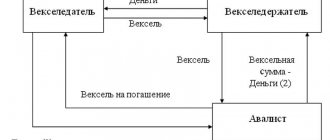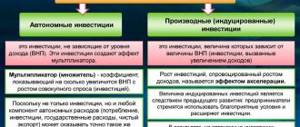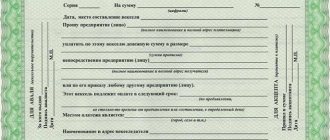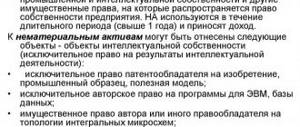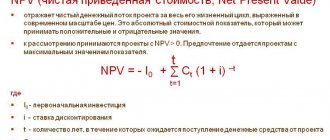The presence of a properly executed bill of exchange does not guarantee trouble-free timely fulfillment of the obligation under it, and the reasons for this can be completely different. At the same time, mechanisms are provided for the creditor to protect his property rights. The main thing is the protest of the bill. This procedure, which is carried out either before or instead of court proceedings, is designed to formalize the fact of non-fulfillment of a specific obligation and stimulate the counterparty to behave in good faith.
Types of protest
Depending on the development of the situation, the creditor may contact the notary with different protest demands. Protests against a promissory note or a bill of exchange may be:
- In non-payment: official confirmation of non-repayment of money.
- Failure to issue the original: initiated when a refusal to issue the original is requested by the owner of the copy.
Only for a simple bill:
- In visa undating: the debtor’s refusal to put a presentation date on a document with payment “after presentation.”
- In non-endorsement: denial of the date of presentation of the document “according to the date of the statement of claim.”
Only by bill of exchange:
- If the drawee is not present at the place of payment: records the absence of the payer.
- In non-acceptance: occurs in case of refusal to accept if the drawee - the payer of the bill - does not accept the paper for payment.
- In undated acceptance: triggered when there is a mark of acceptance, but no date.
The last two protests are made at the place of the drawee.
Notary Amelkina E.A. Departure of a notary to your home, Call of a notary.
A promissory note is a written promissory note
, giving its owner (the drawer) an undisputed, unconditional right, upon expiration of the term, to demand from the debtor payment of a certain amount of money.
A bill of exchange is a notary certification of a certain legal fact.
(refusal to pay on a bill of exchange, absence of the payer at the place of payment, etc.) associated with the implementation of the rights and obligations of the parties to the bill of exchange obligation.
Refusal to accept or pay according to the rules of bill of exchange must be certified by an act drawn up in public order. A bill of exchange can be protested by a notary in three cases:
- non-payment
- non-acceptance
- undated acceptance
When protesting a bill for non-payment
a notary certifies the failure to make payment on a bill on time. This type of protest is made both on a promissory note and on a bill of exchange.
In case of protest for non-acceptance
the fact of non-acceptance of the bill is verified.
Acceptance in bill law means
the payer’s consent to undertake the obligation to pay the bill on time. A protest against acceptance is possible only on a bill of exchange and is made only if the payer refuses to accept the bill at all.
Protest for undating acceptance
occurs when the payer refuses to set an acceptance date. It is also performed if the payer does not object to payment of the bill and confirmed this with acceptance, but did not indicate the date of acceptance. This protest is also only possible using a bill of exchange.
Before accepting a bill of exchange for protest, the notary will check that its form complies with the established requirements. A notary has no right to protest a bill of exchange that lacks at least one mandatory requisite, because such a bill of exchange, according to Art. 144 part 2 of the Civil Code of the Russian Federation is void.
Next, the notary will check whether the deadline for the protest has expired.
The regulations on bills of exchange and promissory notes establish the following deadlines:
- bills for protesting non-payment are accepted by the notary the next day after the expiration of the payment date on the bill, but no later than 12 o'clock on the day following this deadline.
- bills for making a protest for non-acceptance are accepted within the time limits established for presentation for acceptance, i.e. before the payment deadline. Specific deadlines for presenting a bill of exchange for acceptance may be provided for in the bill itself. The bill may indicate a date before which it cannot be presented for acceptance.
Due to the fact that the payer, under Article 24 of the Regulations, is given the right to demand that the bill be presented to him a second time on the next day after the first presentation, the right to contact a notary to file a protest with the bill holder arises if the payer refused to accept upon repeated presentation to him bills. Therefore, if the first presentation of the bill was made on the last day of the period for presentation for acceptance, the protest can still be made the next day.
Since a bill is a security
, the notary issues a receipt to the bill holder for receipt of the bill. Protests against bills of exchange cannot be made using copies.
Within the above deadlines, the notary must not only have time to accept the bill from the bill holder, but also present the bill to the payer, and also, if necessary, protest the bill
.
A notary has the right to perform a notarial act of “protest of a bill” only after this bill is presented to the payer for payment or acceptance.
If the place of the payer of the bill is unknown, the protest of the bill is made without presenting a demand for payment or acceptance of the bill.
If, upon presentation of the bill of exchange by the notary, the bill of exchange is accepted, all costs are paid by the bill holder. In this case, the notary returns the bill with a note of acceptance to the bill holder. If the payer pays the bill, the notary, without making a protest, but having registered receipt of payment in the register, returns the bill to the person who paid it, with an inscription on the bill itself about receipt of payment and other amounts due, for example, with the following content:
Moscow, December twentieth two thousand and nine. I, Amelkina Elena Alekseevna, notary of Moscow, certify that under this bill of exchange the following has been received for transfer to the bill holder: Amount of the bill - five hundred fifty thousand rubles, Interest - ten thousand one hundred rubles, Costs - twenty thousand rubles, Total: Five hundred eighty thousand one hundred rubles .
Registered in the register under No. 7-231 Collected at the rate:
Seal of Notary.
If the payer refuses to pay or accept the bill or if he fails to appear before the notary before the time specified by him, the notary draws up an Act of Protest of Non-Payment or Non-Acceptance
. The deed is registered in the register for notarial acts. A note about the protest is made on the bill itself.
According to the notary protested by the notary for non-payment, non-acceptance or undated acceptance of the bill, the bill holder in accordance with Art. 122 of the Code of Civil Procedure of the Russian Federation has the right to submit an application to the court for the issuance of a court order, which is an executive document.
If a bill of exchange is not protested by a notary for some reason, the obligations under it do not terminate. In this case, the holder of the bill has the right to submit to the court for a promissory note only to the holder of the bill, and for a bill of exchange - only to the acceptor.
And the last thing to keep in mind is that a protest against a bill of exchange for non-payment is made by a notary at the location of the payer or at the place of payment. Protest of a bill for non-acceptance or non-dating of acceptance - at the location of the payer.
Tariff for protesting a bill of exchange by a notary in accordance with Art. 333.28 is 1% of the unpaid amount of the bill, but not more than 20,000 rubles. Additionally, the notary's expenses for visiting the payer or sending a written notice demanding payment of the bill and technical work for preparing the protest are paid.
Protest procedure
The bill of exchange law is strictly formalized. The regulatory framework prescribes a number of mandatory sequential actions that make up the protest procedure:
- The creditor makes a demand for payment from the drawer.
- Having received a refusal, he or his authorized person submits to the notary a statement of protest and the unpaid document. The procedure is carried out only upon presentation of the original. The exception is a protest for non-transmission of the original.
- The notary checks the document for the presence of mandatory details and its compliance with the requirements of bill of exchange legislation. Examines evidence that the claimant presented a document for payment, but was refused or ignored by the principal.
- Having accepted the application, the notary is obliged to appear before the drawer on the same day and demand payment of the bill. If he refuses or cannot pay the bill, a protest of the bill must be made.
- The result of the protest is documented in an act, and a mark is placed on the bill of exchange.
Design nuances
The bill loses its validity if it is not protested or the deadline for protest is missed.
To initiate the process, the applicant provides the original document to the notary office. The filing deadline is strictly regulated by law: 36 hours following the payment expiration date.
The demand can be submitted either orally or in writing. For collecting evidence, official methods with recording of receipt are suitable: registered mail, personal delivery against signature, etc.
There is no need to file a protest against the bill if the payment was made at the request of a notary. Then the bill with the corresponding record of the transfer of funds is returned to the applicant. The claimant pays all costs.
A payment stamp is placed at the time of receipt of money or upon presentation of a transfer with a bank seal.
Obligations of participants
Participants in bill relations - drawer, avalist and endorser - guarantee the fulfillment of their obligations. Failure to fulfill these obligations entails the collection of the amount of the bill, an interest rate of 6% per annum, plus costs for contesting it.
Before the expiration of the term, the creditor must make a demand to the debtor and find out his intentions. All objections of the counterparty are recorded in the act. If the payer does not pay for the accepted security, such refusal is formalized as a protest of non-payment and is addressed to the person who accepted the document.
Protesting a bill of exchange is a procedure regulated by a notary. But you can collect the debt through the court. It does not matter to the court whether the protest is filed with a notary or not. The application can be submitted while observing the statute of limitations.
However, it should be remembered that bill law is considered fundamental and prevails over the norms of civil law.
Place of protesting the bill
Previously, each form of protest had specific requirements for the place of filing. All restrictions have now been lifted. Now notarial instructions do not consider the protest in relation to the territory.
Protest bill
A protest of a bill is recognized as an action provided for by the document in the event that the rights of the owner of the bill are violated. A protest against a bill involves notarization of a circumstance that is relevant to the implementation of the rights arising from the debt document.
In the Russian Federation, working with bills of exchange in order to confirm specific facts regarding the bill of exchange is the prerogative of a notary. It is he who is engaged in protesting the document. A protest is a pre-trial procedure for certifying the fact that the debtor has not fulfilled the bill of exchange obligation. The act certifies specific facts directly related to the legal consequences of non-compliance.
In the absence of a protest, the recourse debtor of the bill of exchange does not owe anything, except in situations where such an obligation is provided for by the document itself. Protesting a bill of exchange is a notarial act in Russia. The act becomes an aid in further filing a monetary claim in court.
Contents of the notarial deed
A notarized deed is proof of protest. It contains a number of mandatory details:
- date and time of reception;
- Full name of the notary;
- Full name and address of the bill holder;
- all details of the bill;
- type of protest;
- date and time of presentation by the notary of the demand to the drawer;
- list of notary actions;
- refusal and motives;
- visa and stamp of the official.
One copy of the act is filed with the original bill of exchange and, with the appropriate inscription, is issued to the bill holder. Another copy is kept in the archives of the notary.
Timing of the protest
According to the law, the period during which a bill of exchange is protested in the Russian Federation is no more than two days . The countdown begins from the next date after the security holder applies to the notary. If a document is being protested, payment for which must be made within a specific time frame from presentation, and the first presentation was on the last day of the deadline, then the protest can be initiated on the next date .
Regulatory legal acts regulate the time limits when a bill of exchange can be presented to a notary to initiate a protest for non-payment. This is the day following the date of the deadline for making payment on the bill, but later than 12 noon.
If the bill is payable upon presentation, the claim must be initiated within 12 calendar months, starting from the moment of its preparation. Since the period of this method of protesting a bill of exchange is regulated for presentation for acceptance. By law, this period is one year from the date of its issuance, unless otherwise provided by the document. Or on the next day, if the paper was officially presented on the last day of the year.
Reference! The provision on the bill - Article 53 of the document, indicates that in situations where the time frame for presentation is violated, the holder of the bill is deprived of his rights regarding endorsers and other obligated persons. The exception is guarantors.
